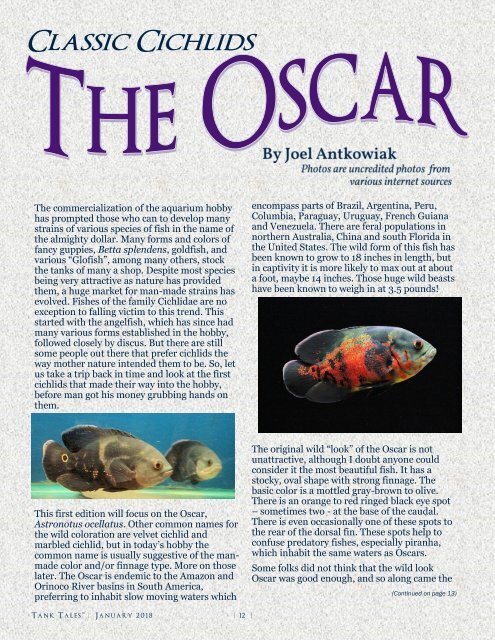Create successful ePaper yourself
Turn your PDF publications into a flip-book with our unique Google optimized e-Paper software.
Classic Cichlids<br />
The commercialization of the aquarium hobby<br />
has prompted those who can to develop many<br />
strains of various species of fish in the name of<br />
the almighty dollar. Many forms and colors of<br />
fancy guppies, Betta splendens, goldfish, and<br />
various “Glofish”, among many others, stock<br />
the tanks of many a shop. Despite most species<br />
being very attractive as nature has provided<br />
them, a huge market for man-made strains has<br />
evolved. Fishes of the family Cichlidae are no<br />
exception to falling victim to this trend. This<br />
started with the angelfish, which has since had<br />
many various forms established in the hobby,<br />
followed closely by discus. But there are still<br />
some people out there that prefer cichlids the<br />
way mother nature intended them to be. So, let<br />
us take a trip back in time and look at the first<br />
cichlids that made their way into the hobby,<br />
before man got his money grubbing hands on<br />
them.<br />
encompass parts of Brazil, Argentina, Peru,<br />
Columbia, Paraguay, Uruguay, French Guiana<br />
and Venezuela. There are feral populations in<br />
northern Australia, China and south Florida in<br />
the United States. The wild form of this fish has<br />
been known to grow to 18 inches in length, but<br />
in captivity it is more likely to max out at about<br />
a foot, maybe 14 inches. Those huge wild beasts<br />
have been known to weigh in at 3.5 pounds!<br />
This first edition will focus on the Oscar,<br />
Astronotus ocellatus. Other common names for<br />
the wild coloration are velvet cichlid and<br />
marbled cichlid, but in today’s hobby the<br />
common name is usually suggestive of the manmade<br />
color and/or finnage type. More on those<br />
later. The Oscar is endemic to the Amazon and<br />
Orinoco River basins in South America,<br />
preferring to inhabit slow moving waters which<br />
The original wild “look” of the Oscar is not<br />
unattractive, although I doubt anyone could<br />
consider it the most beautiful fish. It has a<br />
stocky, oval shape with strong finnage. The<br />
basic color is a mottled gray-brown to olive.<br />
There is an orange to red ringed black eye spot<br />
– sometimes two - at the base of the caudal.<br />
There is even occasionally one of these spots to<br />
the rear of the dorsal fin. These spots help to<br />
confuse predatory fishes, especially piranha,<br />
which inhabit the same waters as Oscars.<br />
Some folks did not think that the wild look<br />
Oscar was good enough, and so along came the<br />
(Continued on page 13)<br />
Tank Tales | <strong>Jan</strong>u ary <strong>2018</strong> | 12 |


